|
Produced by The Center for Baptist
Studies, Mercer University
A Monthly EMagazine, Bridging Baptists
Yesterday and Today
Bruce T. Gourley,
Editor, The
Baptist Studies Bulletin
Wil Platt, Associate Editor, The Baptist Studies
Bulletin
|
| |
|
| |
|
|
In Response to
. . . :
Currently the Interim Director of the Center for Baptist
Studies, Bruce has been on the staff of the Center since 2004. He
previously served as a campus minister and professor of church history.
In addition, he is involved in a number of areas of moderate Baptist life
through the medium of the Internet.
"A
Rural Renewal for Baptists?"
By Bruce T. Gourley
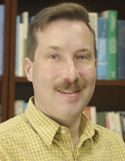
Baptists, a largely rural people until the twentieth century, are now
confronting a rural crisis in the twenty-first century. Like other evangelical
and mainline denominations, today's rural Baptist congregations attract few seminary-trained ministers. This trend within American Christendom
has become so obvious that TIME Magazine recently ran a feature story
entitled,
Rural Exodus From American Churches. According to the article, in
the Midwest only one in five rural congregations is pastored by a full-time,
seminary-trained minister.
Why are today's seminary
grads uninterested in country churches? The reasons appear to be many. To
begin with, most of today's young seminary graduates grew up in metropolitan
areas, accustomed to Starbucks and city life. Today's graduates, frequently incurring significant
debt during their educational sojourn, are more likely to be attracted by the
glimmer of large urban and suburban congregations than the rural, white wooden
clapboard churches that offer meager salaries. In
addition, few young people remain in the pews of country churches even as job
descriptions for rural pastors seemingly hold little enticement for young
ministers seeking the opportunity to be creative and innovative in ministry.
In Baptist life
today, rural churches with memberships of less than one hundred persons still account
for more than half of all congregations in some regions of the country.
Southern Baptists recognize the challenge inherent in the countryside, and one
solution is for
seminary-trained ministers to pastor multiple congregations. The
Cooperative Baptist Fellowship, while comprised of fewer rural congregations,
ministers in the poorest of rural areas through Together for Hope, an effort
to transform communities and individuals by breaking the "cycle
of economic disparity." Nonetheless, few moderate Baptist seminary
graduates pastor country churches.
Are churches
destined to largely vanish from rural America, a victim of ceaseless migration
to big cities and sprawling suburbs? Can twenty-first century Christianity
learn anything from the small towns, hamlets, and farming communities that dot the
countryside?
Although neglected
at the moment, small-church America may harbor the seeds of spiritual,
cultural, and even global renewal. Internally divided along the fault
lines of urban poverty and an upwardly-mobile
Blackberry
generation, contemporary city dynamics foster little economic relief for
the poor, do little to check self-focused consumerism, and in their inherent
busyness tend to inhibit authentic community and stunt self-reflection.
No less than one of
America's most respected and gifted ministers,
Barbara
Brown-Taylor, left the city for the countryside and discovered a spiritual
renewal that bridges the sacred and the secular. She discovered authenticity
in simplicity, creativity in the presence of creation, and community in the
lives of people. In short, leaving the city allowed Brown-Taylor to embark
upon a journey that led to the discovery that time, rather than possessions or
productivity, is the foundation of a healthy faith.
In addition, the
amazing legacy of one the most generous and selfless Baptists of all time,
Millard Fuller, is rooted in rural America.
His recent death mourned worldwide, Fuller devoted his life to building
homes for the homeless throughout the world, personally eschewing financial
success and city life for the
simplicity of the countryside of southwest Georgia. Fuller was a neighbor
of Jimmy Carter, a Baptist who at one time was the most powerful man in the
world and who will be remembered as one of the greatest peacemakers in
history, yet whose spiritual strength and global Christian commitment stems
from a
small Baptist church in a tiny farming community.
True, city churches
need pastors and urban problems must be addressed. But is it possible that the
urbanization of American Christianity has at times sacrificed the best of
community upon the altar of upward-mobility and the shrine of busyness? If so,
then perhaps the key to restoring a healthy and dynamic balance in the life of
Baptists and Christendom at large is more likely to be found in the pew of a
small congregation on the plains of Wisconsin or in the piney woods of
southwest Georgia, than among the theatre seats and
holographic
preachers of America's big cities.
Table of Contents
|
|
Celebrating 400 Years of Being Baptist:
The Center for Baptist Studies and the Baptist
History and Heritage Society present a twelve-month series of free church
bulletin inserts for use in teaching Baptist heritage in the local church
during the 400 year anniversary of Baptists. The image below is a copy of one
side of this month's pdf document. You can view each month's feature (in pdf format) here.
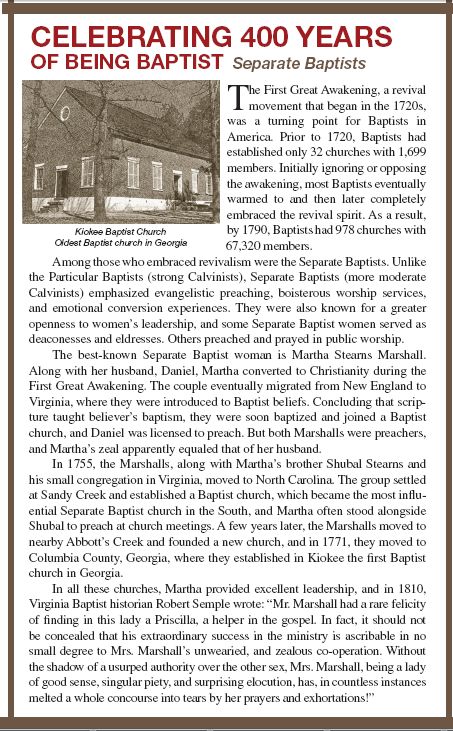 |
Bulletins are
copyrighted
material and
can only be
used for
distribution
within a church.
For permission
to reprint any
text or images,
please contact:
Pamela R. Durso
by email at
pamdurso@
baptisthistory.org
or by phone at (678) 547-6095.
|
Table of Contents
|
|
|
|
The Baptist Soapbox: Invited guests
speak up and out on things Baptist (therefore, the views expressed in this
space are not necessarily those of The Baptist Studies Bulletin, though
sometimes they are).
Climbing upon the Soapbox this month is David
D' Amico, who with his wife Ana served as Cooperative Baptist Fellowship
diplomatic missionaries to the United Nations.
"Some
Things I Learned as a Baptist at the United Nations"
By David D'Amico

It was a great privilege for my wife Ana and me to have
represented the Cooperative Baptist Fellowship as Non-governmental
(NGO) representatives to the United Nations in New York from 1996
to 2004. During our sojourn in the most exciting city of the
world, I learned a lot. My intellectual, spiritual, physical and
vocational attitudes were transformed by the experiences.
The UN is an
imperfect institution, a confederacy of autonomy, where each
nation state defends its status with pride. It is an institution
organized in the early 1950s. Many believe it needs significant
organizational reform. The Security Council membership, a vestige
of the Cold War, stands in the way of reform despite the efforts
of many nation states to have representation and the coveted “veto
power.”
The
UN is still a symbol of the ideals of many in the world for a
place where nations can reason together to improve the lot of
humanity. The view of the 191 flags in front of the Secretariat
building at First Avenue
symbolizes the aspirations of many.
The
Church Center of the UN (CCUN) is a multi-story building across
from the UN headquarters. The building was erected in part by the
efforts of Methodist women from around the country who collected
funds and lobbied the denomination in the 1960s. In the first
floor there is an interreligious chapel providing a haven for
prayer, celebrations, and witness.
Some religious principles guided the founding of the UN. These are
observed and are vaguely present in symbolic and tangible
ways―the chapel, the Millennium religious forum in 2000, the
Millennium Goals for development, and the active involvement of
religious NGOs,
Religious bodies of all types from around the world have been
actively involved with the UN since the beginning. Baptists have
been represented at the UN since its beginnings. American Baptists
have been more actively engaged until recent years. James Dawson,
a Baptist stalwart, was instrumental in alerting Baptists about
the value of the UN during the years leading to its founding. He
was an active spokesperson to represent Baptist views about Human
Rights and religious freedom. As the Chairperson of the Baptist
Joint Committee of Public Affairs, now Baptist Joint Committee for
Religious Liberty, he
narrated in his memoirs the sense of expectancy he experienced
when he attended, in 1945, the organizational meeting of the
United Nations in San Francisco. “To that meeting I carried a
hundred thousand petitions from Baptists, North and South, white
and Negro, asking that the Charter to be adopted would include a
guarantee of full religious liberty for every human being.”
[Dawson, A Thousand Months to Remember, p. 161].
Dawson later addressed the Baptist World Congress in
Copenhagen in 1947
setting high hopes for the value of the UN in world affairs. “We
hope also for the United Nations to inaugurate a new birth of
religious freedom for the world.” [1947 Baptist World Congress
Minutes, p. 71].
Several UN General Secretaries have shared their personal
religious convictions while in office. The most notable were Dag
Hammarskjold and Kofi Annan. In 1996 the Methodist World
Federation conferred upon Mr. Annan the Methodist Peace Prize. It was inspiring to hear Annan when
he testified of his Methodist roots, his having been trained in a
Presbyterian college in the US, and of his commitment to
peacemaking. Later he was the recipient with the UN of the Nobel
Peace Prize. Now retired, he is an ambassador for peace.
Some Southern Baptist leaders discussed, during the 1950s and
1960s, how to have representation at the UN. Whereas the Christian
Life Commission was the logical agency to represent Southern
Baptists, and desired to have a voice and a representative at the
UN, it did not have enough resources. The Language Missions
division of the Home Mission Board profited from its evangelistic
emphasis and financial strength and maintained a representative as
a home missionary until the 1990s. It has continued its
representation under a different mandate.
During the
early years of the UN, Southern Baptists were interested in the UN
because of a fear of communism and a desire defend
religious liberty in nations under the aegis of the Soviet Union.
Elias Golenka was selected to represent Southern Baptists. He was a well prepared
and incisive missionary. He emphasized the Communist threat.
Because he had expertise in Eastern European issues he kept an
ongoing alert to Southern Baptists in an area where Baptists were interested.
During the years we ministered at the UN, CBF cooperated with the
ecumenical community in revising “The Pillars of Peace,” a
document approved by the National Council of Churches of the US. We
were invited to be members of the Task Force on the UN, an
informal group composed of representatives of different Christian
persuasions.
The
task force, in cooperation with the American Bible Society, launched
the
republication of the booklet, “Life in All Its Fullness: The Word
of God and Human Rights.” One million copies were printed on the
occasion of the 50th anniversary of the United Nations Declaration
of Human Rights (UNDHR) in 1998 and distributed free of charge to
interested churches and individuals.
The
Baptist constituency is concerned with many issues with which the
UN deals constantly. Baptist distinctives and biblical
principles are in accordance with the social programs of many
agencies of the UN. The role of religion in the UN has been
analyzed in a booklet, Religion and Public Policy at the UN,
published in April 2002.
CBF
officially adopted the “Millennium Development Goals” of the UN in
2007 thanks to the intensive efforts of some enthusiastic members
of “Younger Leaders Network.”
It
was for me a wonderful, stimulating and enriching period of my life
to have ministered at the UN.
Table of Contents
|
Ministering Together in Community:
A Baptist Women in Ministry Series: Reverend
Robin Anderson is associate pastor, education and outreach, at University
Baptist Church in Baltimore, Maryland. She serves as the coordinator of
Baptist Women in Ministry.
"Staff Relationships: Women
and Men Working Together as Leaders"
By Robin Anderson
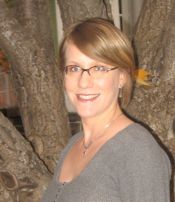
In some ways, writing in 2009 about how
women and men serving in ministry can effectively work together as
leaders seems strange. But the truth is that women are still
stepping into ministry positions in which they feel a need to
prove their abilities to their co-workers and their churches, and many male pastors who are
supportive of women in ministry find themselves suddenly serving
with a female minister, wondering what the dynamic of their
relationship should be like.
In no way do I consider myself to be an
expert on staff relationships, but I have had the opportunity to
serve in ministry with several different pastors and interim
pastors. In some of these relationships, the pastor and I have
experienced tension as we learned how to work together. Other relationships, however, have truly been wonderful
experiences in which the pastor and I easily worked together,
allowing our uniqueness to complement each other and making the
most of each other’s strengths. My hope is that each of us can
have more of the second type of ministry experiences.
In my experiences, when the pastor and I
have struggled to discover how we could best serve together,
one of two factors has been at play. Either I have felt a need to
prove myself to my pastor or to the church or the pastor
has been nervous about how to work closely with a female colleague
and has had difficulty communicating to me how he wanted our
relationship to function. In situations in which I felt a need to
prove myself as a female minister, I sought to demonstrate how
well I could accomplish tasks on my own, while the pastors I
served with hoped that we would work together as a team. In these
situations, I learned from being affirmed in the work that I was
doing and benefited from being invited to be a part of
collaborative projects. These steps gave me permission to ask for
input or advice without feeling as though the pastor would find my
skills to be inadequate.
In situations in which the pastor has had
reservations about how a man and woman work closely together, tensions ensued when the pastor tried to work with me in
the same manner as he worked with men even though he was
uncomfortable doing so. For example, if the pastor has felt
uneasy meeting alone with me but did so anyway, I sensed his
nervousness, which, of course, also made me nervous. Having a
productive meeting when both people are nervous is extremely
uncomfortable! When these situations have arisen, the pastor and I
have been able to work through them when we have communicated to
each other the circumstances that make us uncomfortable so that
neither of us had to wonder why the other seemed so uneasy. Then
we could discuss alternatives to the situations that enable both
of us to feel comfortable. In my experience, the issues that may
make someone uneasy at first soon are overcome after a while if
the ministers do not ignore the issues and allow the tension to
grow.
The truth is
that women and men who serve together and who do not allow their
differences to create tension between them have a wonderful
opportunity to allow their uniqueness to strengthen each other’s
ministry as well as the ministry of the entire church. These
relationships can be amazing opportunities to collaborate, to
grow, and to demonstrate the fullness of God to our churches!
Table of Contents
|
|
|
|
The
Baptist Heritage, Today:
This month we bring to
your attention a challenge facing William Carey's home church in Moulton,
England. In 2005, Carey Baptist Church was on the itinerary of a Baptist
Heritage Tour of England in conjunction with the Baptist World Alliance
meeting in Birmingham. Pastor David Gamston graciously welcomed us, took us on
a tour of the historic structure, and patiently answered our many questions. Now, Gamston
relates a new challenge facing the congregation. Note: The
photos below were taken by Bruce Gourley during the 2005
Baptist Heritage Tour.
Carey Baptist Church, Moulton, England
by David Gamston
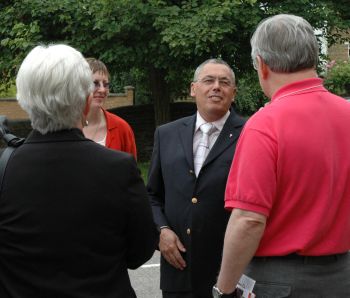
Carey Baptist Church is a small but active church situated
in a large village on the outskirts of Northampton, England. We have a
membership of some sixty people who vary in ages from their late twenties to
their middle eighties. Our worship is varied and quite lively at times with
the preaching of the word taking central stage. We have a number of young
people’s groups within the church including Boys’ Brigade, Girls’ Brigade and
a small group of young people who meet after church on Sunday evenings. We
are involved in many aspects of village life and our rooms are used by various
organisations throughout the week.
This is a special church with historic significance being the church where
William Carey, pioneer of Baptist missionary activities, was pastor before his
removal to Leicester and his journey to India. Throughout the year we welcome
many visitors who travel from near and far, as they come to see our church,
visit the museum, and thank God for Carey’s vision and his willingness to take
the gospel to other lands. I am privileged to be the minister here today. I
share with you now a few thoughts, my own and of others, on what makes this
place so special.
The Baptist witness in Moulton preceded William Carey’s settlement here in
1785 by perhaps more than a century. A religious census of the district dated
in 1676 records 29 “dissenters” in the village and more specifically there are
records of vigorous Baptist ministries by William Stanger and his son, Thomas,
during the first half of the 18th Century. Concurrently with the
“General” Baptist witness of the Strangers, a small group of “Particular”
Baptists, 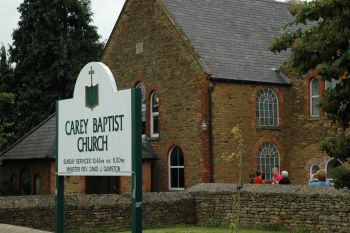 enrolled at College Lane, Northampton, met regularly for worship at
Moulton, and to these stalwart, if austere, pioneers the Baptist torch was
passed when later the General Baptists embraced Unitarian doctrines and
declined. It is clear, however, that the flame burned very low when Carey
arrived in the village. “Pastor less for tens of years, their services had
been irregular and rare. For months their meeting was closed and fell in
dilapidation and dishonour.” enrolled at College Lane, Northampton, met regularly for worship at
Moulton, and to these stalwart, if austere, pioneers the Baptist torch was
passed when later the General Baptists embraced Unitarian doctrines and
declined. It is clear, however, that the flame burned very low when Carey
arrived in the village. “Pastor less for tens of years, their services had
been irregular and rare. For months their meeting was closed and fell in
dilapidation and dishonour.”
Part of the present structure dates from 1750, when Thomas Stanger took the
lead in the erection of a Meeting House, but when Carey came this had “become
so ruinous” that the congregation ran “the risqué of being buried” in it
(words of Carey himself as recorded in Church Minutes). As a result of an
appeal by Carey to his friends, the sum of £100 was raised, enabling him to
repair the chapel and enlarge it to thirty feet square. His pulpit stood
where there is now a tablet to his memory. There are records of a gallery
extending round three sides of the building, but probably this was erected
after Carey’s period in Moulton. A vestry and lecture room, with a large
schoolroom was added in 1861 and the entrance of the church, from and
including the gallery, was added in 1870.
In 1955 a £5,000 extension scheme made possible the building of a new manse,
followed three years later by the William Carey Memorial Hall. Most of the
money required for 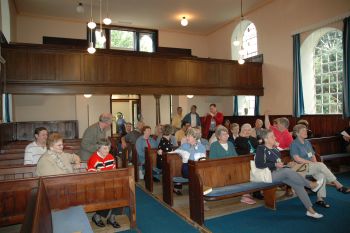 this was given by our own members, but it is significant of
the universal esteem in which the name of William Carey is held, that many
Baptist friends in this and other countries gave us considerable financial
help, which we are glad to acknowledge. In 1991 a vestibule was built to give
a more spacious and welcoming entrance to the church and in the same year, in
preparation for the 200th anniversary of the formation of the
Baptist Missionary Society, the Moulton Art Group produced six fine painted
panels depicting the life and work of William Carey which are displayed on the
wall alongside his memorial tablet. In 1997, to meet the needs of a new
generation, a far reaching three phase plan was proposed to refurbish the
chapel, hall and ancillary rooms. At a cost of almost £200,000, which was
entirely raised by the membership, phase one and two have now been completed. This year in 2009 we hope to bring the three phase plan to its completion as
we refurbish the chapel. This will cost the sum of £230,000. In faith the
membership have already given over two thirds of this amount but now need to
find the remaining £40,000. This final stage of refurbishment desperately
needs to go ahead as a severe infestation of worm in the interior woodwork
makes the chapel unsafe for worship. In fact as in Carey’s day we fear that
it “becomes so ruinous” that the congregation run “the risqué of being buried”
in it. I appeal therefore to our many Baptist friends, some of whom have
visited us here at Moulton, for prayerful concern and if possible financial
help at this time. Any gift will be greatly appreciated and acknowledged. We
go forward together in faith remembering the words of the great man himself
“Expect great things from God: Attempt great things for God”. this was given by our own members, but it is significant of
the universal esteem in which the name of William Carey is held, that many
Baptist friends in this and other countries gave us considerable financial
help, which we are glad to acknowledge. In 1991 a vestibule was built to give
a more spacious and welcoming entrance to the church and in the same year, in
preparation for the 200th anniversary of the formation of the
Baptist Missionary Society, the Moulton Art Group produced six fine painted
panels depicting the life and work of William Carey which are displayed on the
wall alongside his memorial tablet. In 1997, to meet the needs of a new
generation, a far reaching three phase plan was proposed to refurbish the
chapel, hall and ancillary rooms. At a cost of almost £200,000, which was
entirely raised by the membership, phase one and two have now been completed. This year in 2009 we hope to bring the three phase plan to its completion as
we refurbish the chapel. This will cost the sum of £230,000. In faith the
membership have already given over two thirds of this amount but now need to
find the remaining £40,000. This final stage of refurbishment desperately
needs to go ahead as a severe infestation of worm in the interior woodwork
makes the chapel unsafe for worship. In fact as in Carey’s day we fear that
it “becomes so ruinous” that the congregation run “the risqué of being buried”
in it. I appeal therefore to our many Baptist friends, some of whom have
visited us here at Moulton, for prayerful concern and if possible financial
help at this time. Any gift will be greatly appreciated and acknowledged. We
go forward together in faith remembering the words of the great man himself
“Expect great things from God: Attempt great things for God”.
Top photo - David Gamston talks with Buddy Shurden;
middle photo - the exterior of Carey Baptist Church; bottom photo - the
sanctuary of Carey Baptist Church. David Gamston may be contacted by
email.
Table of Contents
|
|
| |
|
Recommended Online Baptist Heritage Sources
Compiled by Bruce Gourley
Habitat for Humanity Founder Millard Fuller Dies
Associated Baptist Press
"Millard Fuller, a millionaire entrepreneur who gave away his fortune to
create Habitat for Humanity International in 1976, died Feb. 3 after a brief
illness. Fuller, 74, led the worldwide house-building ministry with his wife,
Linda, for 29 years before both were fired in January 2005 following several
months of conflict with their board of directors. Afterward Fuller formed a
new organization, the Fuller Center for Housing."
Abraham Lincoln's Religious Uncertainty
U.S. News and World Report
Unlike that of recent American presidents, so eager to testify about
their "come to Jesus" experiences, the exact nature of Abraham Lincoln's
religious faith is hard to pin down.
Obama Details Plans for White House Faith-Based Office
Baptist Joint Committee for Religious Liberty
In keeping with a campaign promise to establish a real partnership
between the White House and faith-based social service providers, “not a
photo-op,” President Barack Obama signed an executive order today revamping a
White House office and naming an advisory council to help the administration
develop and implement policy related to the provision of social services by
faith-based and neighborhood organizations. |
|
| |
|
| |
|
Dates to Note
February 23-24, 2009,
T. B. Maston Lectures,
Carson-Newman College Jefferson City, Tennessee. Monday, February 23, 7:30 P.M.
Thomas Recital Hall. Tuesday, February 24, 9:30 A.M. First Baptist Church.
Featured speaker: Reverend Paul Rauschenbush, Associate Dean of the Chapel,
Princeton University.
March 5-6, 2009, Social Research Conference
Series, The Religious-Secular Divide: The US Case, New York City. Join
distinguished scholars and intellectuals in exploring the nature and future of
religion, spirituality, and secularism in the United States, looking at their
changing relations both historically and through contemporary debates. The
keynote address will be delivered by Charles Taylor, Professor, Northwestern
University.
More information.
April 14-15, 2009, "The Walter B. and Kay
W. Shurden Lectures on Religious Liberty and Separation of Church and State,"
Macon, Georgia campus of Mercer University. Professor Randall Balmer,
professor of American religious history at Barnard College, Columbia
University, will deliver the lectures.
June 4-6, 2009, Baptist History and Heritage
Society Annual Meeting, Huntsville, Alabama. Hosted by First Baptist
Church, Huntsville. Theme: Events Shaping Baptist Heritage in America.
More information.
June 26-28, 2009, American Baptist Churches USA
biennial meeting, Pasadena, California.
More information.
July 2-3, 2009, Cooperative Baptist Fellowship
General Assembly, Houston, Texas.
More information.
July 15-18, 2009,
International Conference on Baptist Studies V, Whitley College (Baptist
College of Victoria), Melbourne, Australia. The conference takes Baptists as
its subject matter, but participation is not restricted to Baptists, either as
speakers or attendees. The theme is "Interfaces--Baptists and Others," which
includes relations with other Christians, other faiths, and other movements
such as the Enlightenment. It may be explored by means of case studies, some
of which may be very specific in time and place while others may cover long
periods and more than one country. Offers of papers to last no more than 25
minutes in delivery (although the full text may be longer) are welcome. Please submit the title to the conference coordinator, Professor David W. Bebbington, Department of History, University of Stirling, Stirling FK9 4TB,
Scotland. A volume of conference papers will appear in the Studies in
Baptist History and Thought series, published by Paternoster Press. The
college will provide participants with full board over the three days of
the meeting and all charges will be kept as low as possible. Programs and
application forms will be available in a few months.
September 27-29, 2009, Mercer Preaching
Consultation, King & Prince Beach & Golf Resort, St. Simons Island, Georgia. Featured
speaker: Dr. Walter Brueggemann. To register or for more information, contact
Terri Massey by email or phone her
at 478.301.2943.
If you know of a Baptist event that needs to be added to
this list, please
let us know.
Table Of Contents
|
|
| |
If
you do not wish to receive the BSB any longer, please
click here to unsubscribe. |